Management Accounting: Cost Analysis, Variances, and Costing Methods
VerifiedAdded on 2023/06/10
|13
|2941
|499
Report
AI Summary
This management accounting report provides a detailed analysis of various costing methods and variance calculations. It begins with an introduction to management accounting, highlighting its role in decision-making. The report uses the high-low method to evaluate variable costs and fixed operating costs, and calculates total expected costs at different occupancy rates. It also computes total variable cost, total fixed cost, and average costs per unit at varying activity levels. Furthermore, the report includes schedules for the cost of goods sold and an income statement, followed by a thorough variance analysis, including materials price variance, materials usage variance, labor rate variance, labor efficiency variance, and variable overhead variances. The report discusses potential causes for material usage and labor efficiency variances, and examines different types of variances in relation to work performance. Finally, it analyzes relevant costs for make-or-buy decisions, considering opportunity costs and incremental costs to determine the most cost-effective approach.
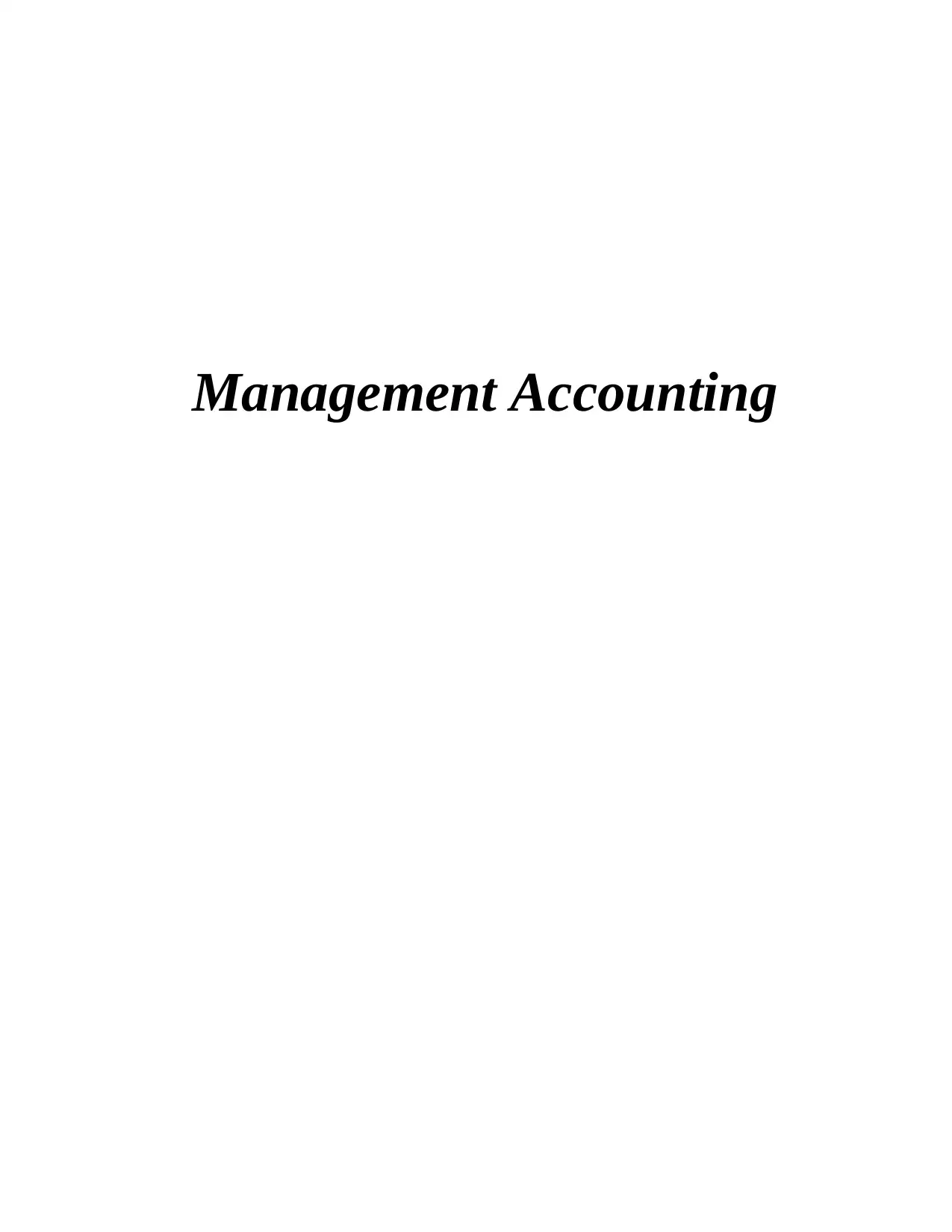
Management Accounting
Paraphrase This Document
Need a fresh take? Get an instant paraphrase of this document with our AI Paraphraser
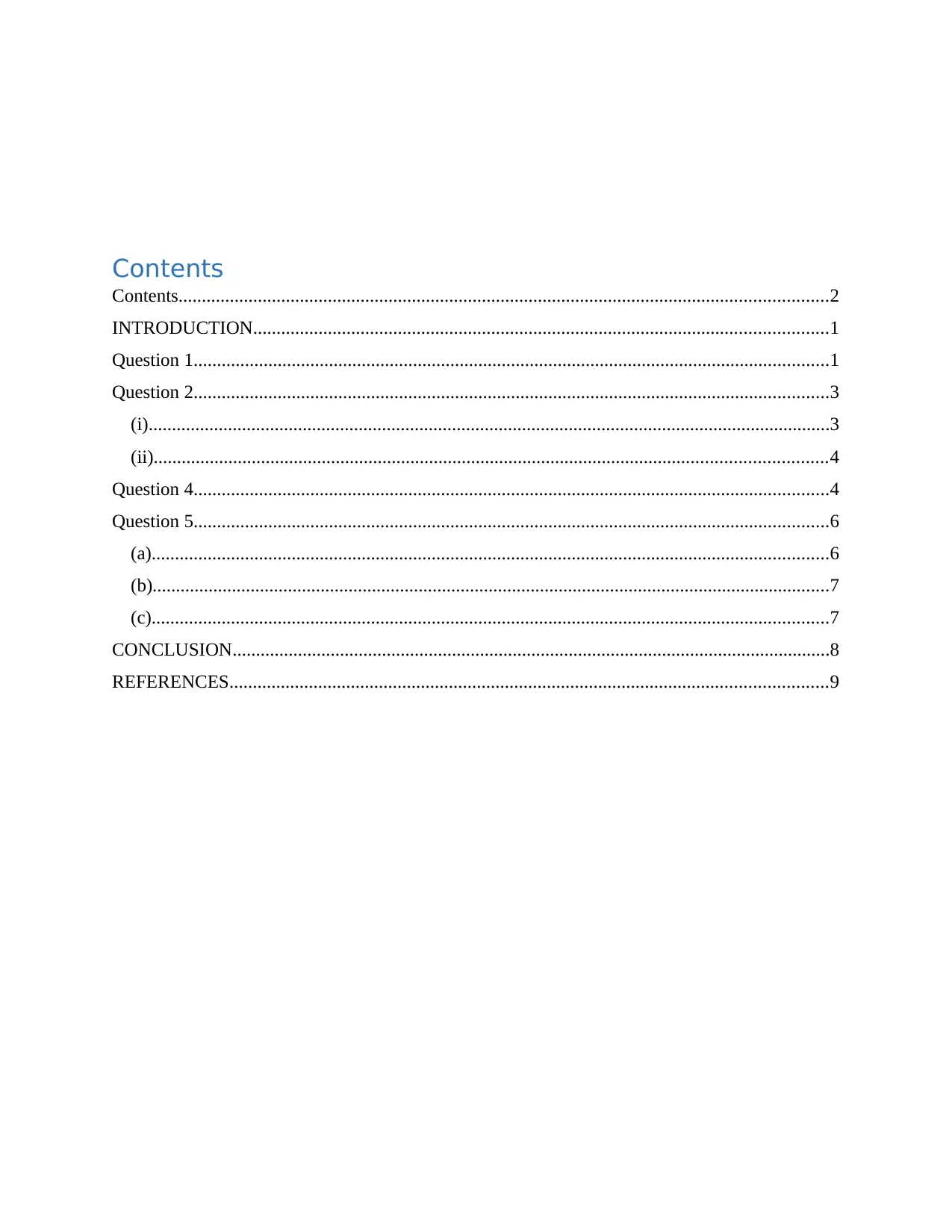
Contents
Contents...........................................................................................................................................2
INTRODUCTION...........................................................................................................................1
Question 1........................................................................................................................................1
Question 2........................................................................................................................................3
(i)..................................................................................................................................................3
(ii)................................................................................................................................................4
Question 4........................................................................................................................................4
Question 5........................................................................................................................................6
(a).................................................................................................................................................6
(b).................................................................................................................................................7
(c).................................................................................................................................................7
CONCLUSION................................................................................................................................8
REFERENCES................................................................................................................................9
Contents...........................................................................................................................................2
INTRODUCTION...........................................................................................................................1
Question 1........................................................................................................................................1
Question 2........................................................................................................................................3
(i)..................................................................................................................................................3
(ii)................................................................................................................................................4
Question 4........................................................................................................................................4
Question 5........................................................................................................................................6
(a).................................................................................................................................................6
(b).................................................................................................................................................7
(c).................................................................................................................................................7
CONCLUSION................................................................................................................................8
REFERENCES................................................................................................................................9
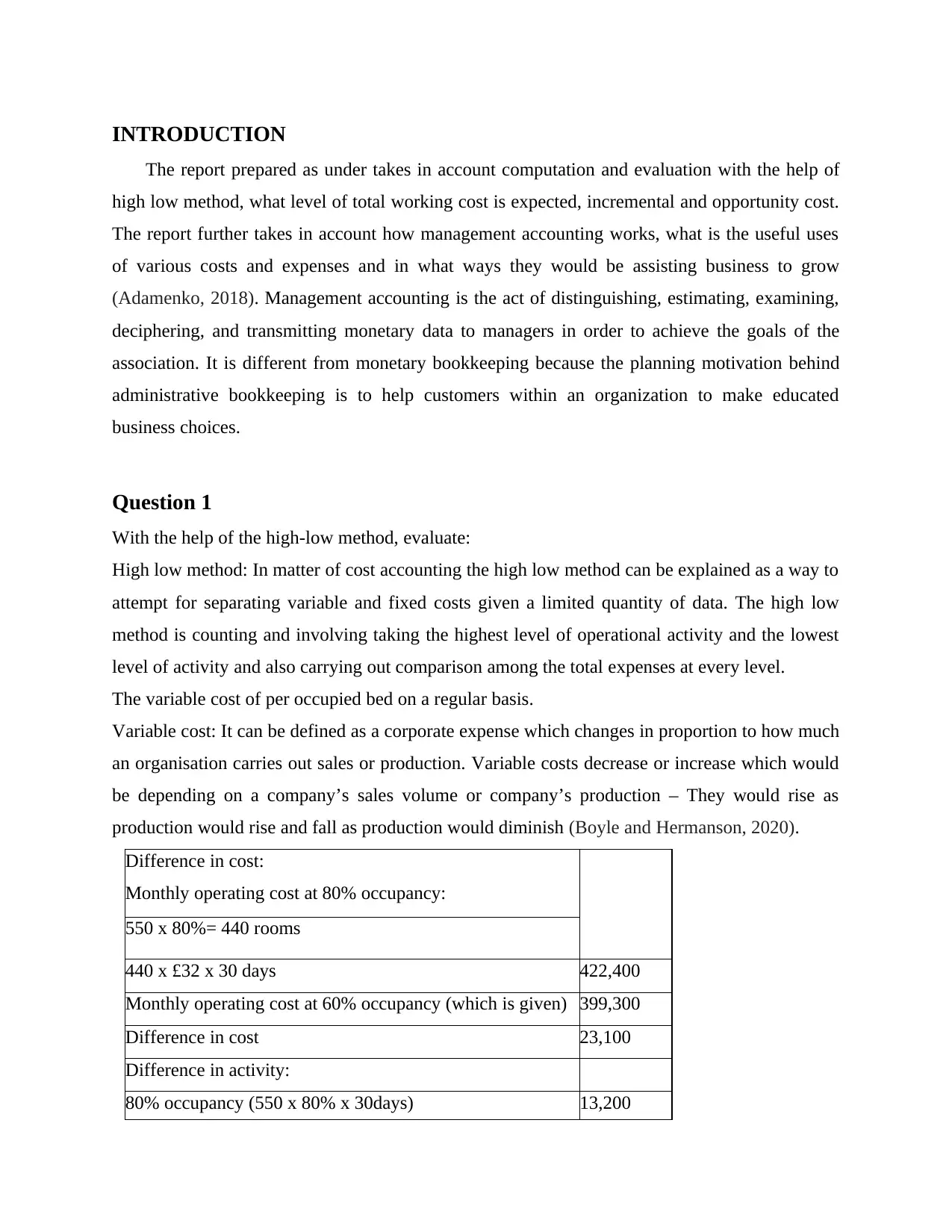
INTRODUCTION
The report prepared as under takes in account computation and evaluation with the help of
high low method, what level of total working cost is expected, incremental and opportunity cost.
The report further takes in account how management accounting works, what is the useful uses
of various costs and expenses and in what ways they would be assisting business to grow
(Adamenko, 2018). Management accounting is the act of distinguishing, estimating, examining,
deciphering, and transmitting monetary data to managers in order to achieve the goals of the
association. It is different from monetary bookkeeping because the planning motivation behind
administrative bookkeeping is to help customers within an organization to make educated
business choices.
Question 1
With the help of the high-low method, evaluate:
High low method: In matter of cost accounting the high low method can be explained as a way to
attempt for separating variable and fixed costs given a limited quantity of data. The high low
method is counting and involving taking the highest level of operational activity and the lowest
level of activity and also carrying out comparison among the total expenses at every level.
The variable cost of per occupied bed on a regular basis.
Variable cost: It can be defined as a corporate expense which changes in proportion to how much
an organisation carries out sales or production. Variable costs decrease or increase which would
be depending on a company’s sales volume or company’s production – They would rise as
production would rise and fall as production would diminish (Boyle and Hermanson, 2020).
Difference in cost:
Monthly operating cost at 80% occupancy:
550 x 80%= 440 rooms
440 x £32 x 30 days 422,400
Monthly operating cost at 60% occupancy (which is given) 399,300
Difference in cost 23,100
Difference in activity:
80% occupancy (550 x 80% x 30days) 13,200
The report prepared as under takes in account computation and evaluation with the help of
high low method, what level of total working cost is expected, incremental and opportunity cost.
The report further takes in account how management accounting works, what is the useful uses
of various costs and expenses and in what ways they would be assisting business to grow
(Adamenko, 2018). Management accounting is the act of distinguishing, estimating, examining,
deciphering, and transmitting monetary data to managers in order to achieve the goals of the
association. It is different from monetary bookkeeping because the planning motivation behind
administrative bookkeeping is to help customers within an organization to make educated
business choices.
Question 1
With the help of the high-low method, evaluate:
High low method: In matter of cost accounting the high low method can be explained as a way to
attempt for separating variable and fixed costs given a limited quantity of data. The high low
method is counting and involving taking the highest level of operational activity and the lowest
level of activity and also carrying out comparison among the total expenses at every level.
The variable cost of per occupied bed on a regular basis.
Variable cost: It can be defined as a corporate expense which changes in proportion to how much
an organisation carries out sales or production. Variable costs decrease or increase which would
be depending on a company’s sales volume or company’s production – They would rise as
production would rise and fall as production would diminish (Boyle and Hermanson, 2020).
Difference in cost:
Monthly operating cost at 80% occupancy:
550 x 80%= 440 rooms
440 x £32 x 30 days 422,400
Monthly operating cost at 60% occupancy (which is given) 399,300
Difference in cost 23,100
Difference in activity:
80% occupancy (550 x 80% x 30days) 13,200
⊘ This is a preview!⊘
Do you want full access?
Subscribe today to unlock all pages.

Trusted by 1+ million students worldwide
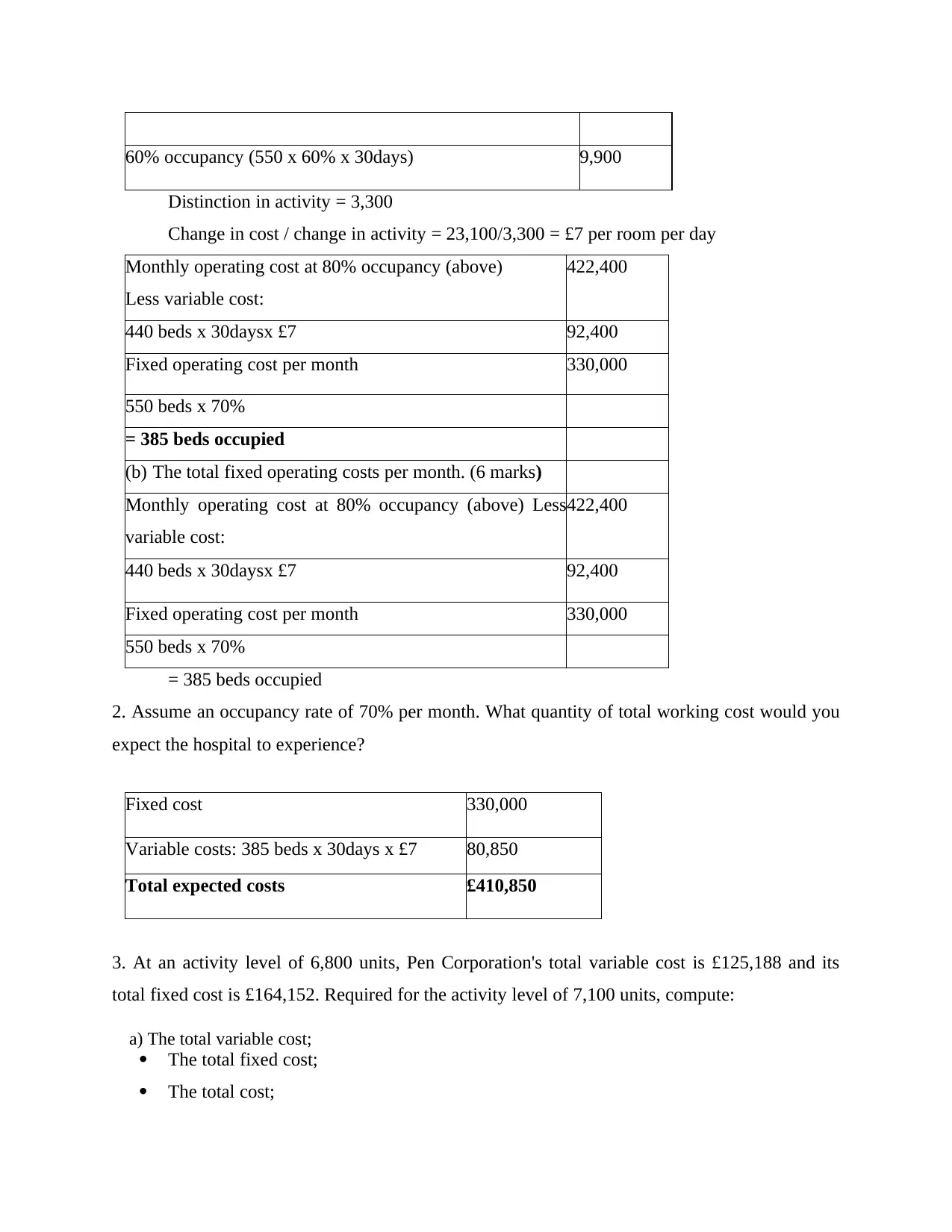
60% occupancy (550 x 60% x 30days) 9,900
Distinction in activity = 3,300
Change in cost / change in activity = 23,100/3,300 = £7 per room per day
Monthly operating cost at 80% occupancy (above)
Less variable cost:
422,400
440 beds x 30daysx £7 92,400
Fixed operating cost per month 330,000
550 beds x 70%
= 385 beds occupied
(b) The total fixed operating costs per month. (6 marks)
Monthly operating cost at 80% occupancy (above) Less
variable cost:
422,400
440 beds x 30daysx £7 92,400
Fixed operating cost per month 330,000
550 beds x 70%
= 385 beds occupied
2. Assume an occupancy rate of 70% per month. What quantity of total working cost would you
expect the hospital to experience?
Fixed cost 330,000
Variable costs: 385 beds x 30days x £7 80,850
Total expected costs £410,850
3. At an activity level of 6,800 units, Pen Corporation's total variable cost is £125,188 and its
total fixed cost is £164,152. Required for the activity level of 7,100 units, compute:
a) The total variable cost;
The total fixed cost;
The total cost;
Distinction in activity = 3,300
Change in cost / change in activity = 23,100/3,300 = £7 per room per day
Monthly operating cost at 80% occupancy (above)
Less variable cost:
422,400
440 beds x 30daysx £7 92,400
Fixed operating cost per month 330,000
550 beds x 70%
= 385 beds occupied
(b) The total fixed operating costs per month. (6 marks)
Monthly operating cost at 80% occupancy (above) Less
variable cost:
422,400
440 beds x 30daysx £7 92,400
Fixed operating cost per month 330,000
550 beds x 70%
= 385 beds occupied
2. Assume an occupancy rate of 70% per month. What quantity of total working cost would you
expect the hospital to experience?
Fixed cost 330,000
Variable costs: 385 beds x 30days x £7 80,850
Total expected costs £410,850
3. At an activity level of 6,800 units, Pen Corporation's total variable cost is £125,188 and its
total fixed cost is £164,152. Required for the activity level of 7,100 units, compute:
a) The total variable cost;
The total fixed cost;
The total cost;
Paraphrase This Document
Need a fresh take? Get an instant paraphrase of this document with our AI Paraphraser
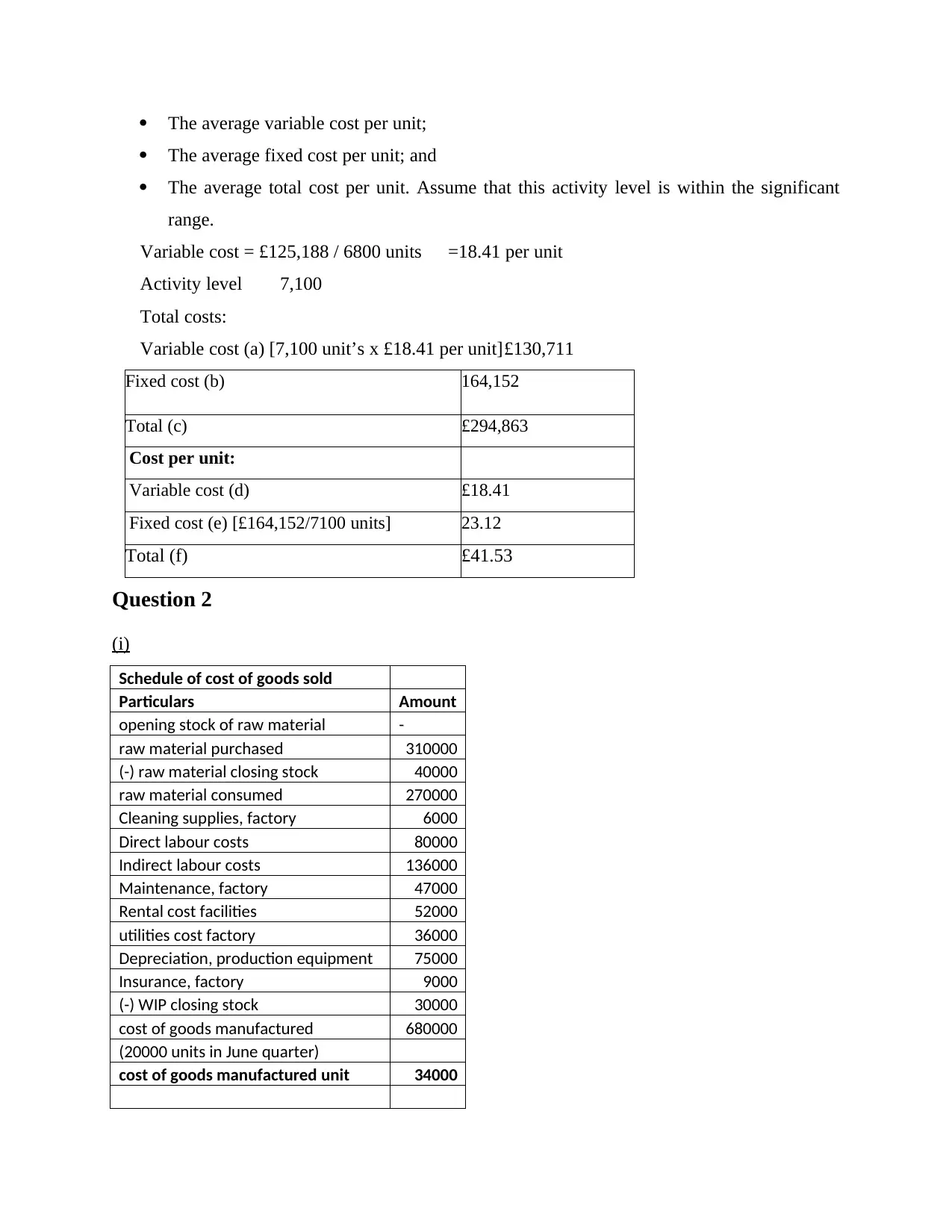
The average variable cost per unit;
The average fixed cost per unit; and
The average total cost per unit. Assume that this activity level is within the significant
range.
Variable cost = £125,188 / 6800 units =18.41 per unit
Activity level 7,100
Total costs:
Variable cost (a) [7,100 unit’s x £18.41 per unit]£130,711
Fixed cost (b) 164,152
Total (c) £294,863
Cost per unit:
Variable cost (d) £18.41
Fixed cost (e) [£164,152/7100 units] 23.12
Total (f) £41.53
Question 2
(i)
Schedule of cost of goods sold
Particulars Amount
opening stock of raw material -
raw material purchased 310000
(-) raw material closing stock 40000
raw material consumed 270000
Cleaning supplies, factory 6000
Direct labour costs 80000
Indirect labour costs 136000
Maintenance, factory 47000
Rental cost facilities 52000
utilities cost factory 36000
Depreciation, production equipment 75000
Insurance, factory 9000
(-) WIP closing stock 30000
cost of goods manufactured 680000
(20000 units in June quarter)
cost of goods manufactured unit 34000
The average fixed cost per unit; and
The average total cost per unit. Assume that this activity level is within the significant
range.
Variable cost = £125,188 / 6800 units =18.41 per unit
Activity level 7,100
Total costs:
Variable cost (a) [7,100 unit’s x £18.41 per unit]£130,711
Fixed cost (b) 164,152
Total (c) £294,863
Cost per unit:
Variable cost (d) £18.41
Fixed cost (e) [£164,152/7100 units] 23.12
Total (f) £41.53
Question 2
(i)
Schedule of cost of goods sold
Particulars Amount
opening stock of raw material -
raw material purchased 310000
(-) raw material closing stock 40000
raw material consumed 270000
Cleaning supplies, factory 6000
Direct labour costs 80000
Indirect labour costs 136000
Maintenance, factory 47000
Rental cost facilities 52000
utilities cost factory 36000
Depreciation, production equipment 75000
Insurance, factory 9000
(-) WIP closing stock 30000
cost of goods manufactured 680000
(20000 units in June quarter)
cost of goods manufactured unit 34000
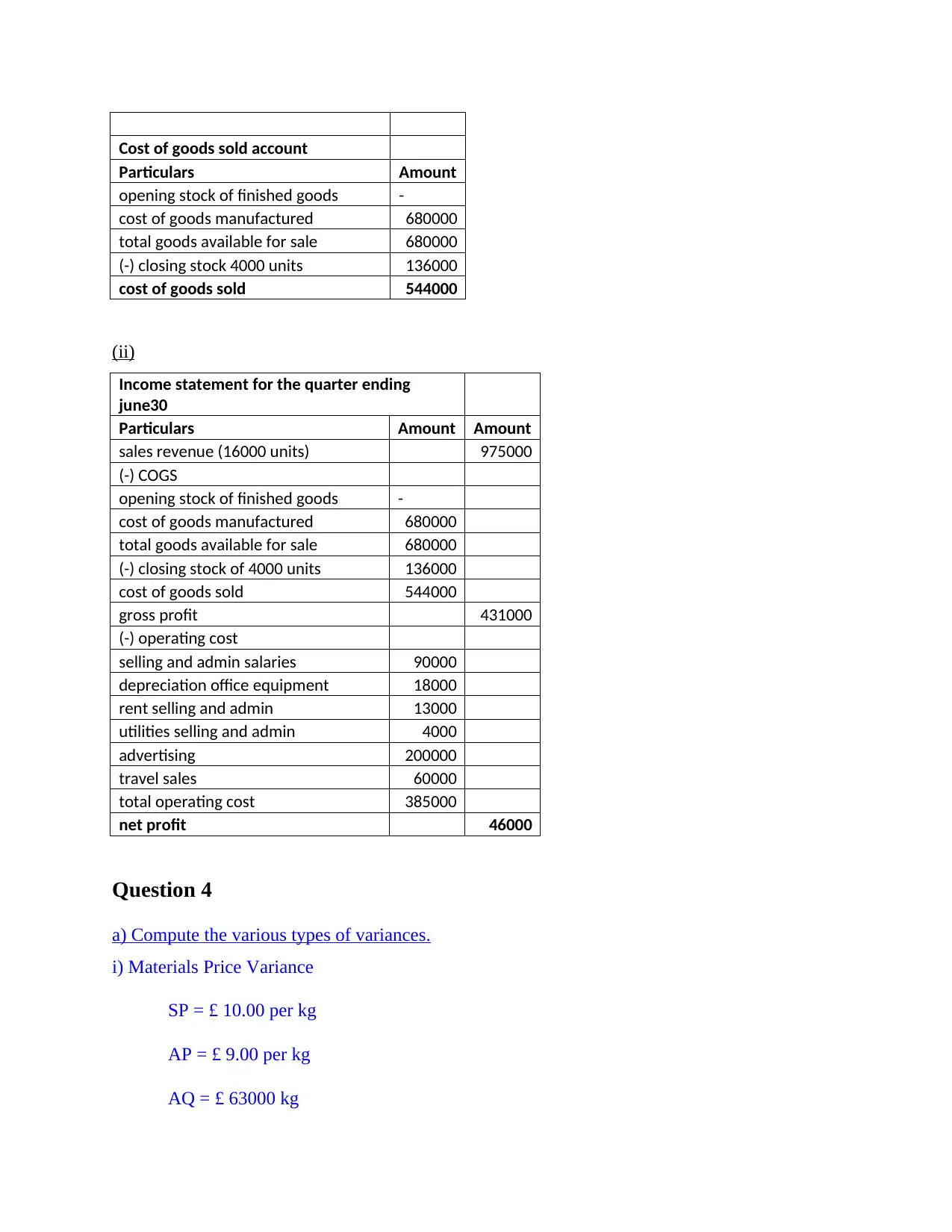
Cost of goods sold account
Particulars Amount
opening stock of finished goods -
cost of goods manufactured 680000
total goods available for sale 680000
(-) closing stock 4000 units 136000
cost of goods sold 544000
(ii)
Income statement for the quarter ending
june30
Particulars Amount Amount
sales revenue (16000 units) 975000
(-) COGS
opening stock of finished goods -
cost of goods manufactured 680000
total goods available for sale 680000
(-) closing stock of 4000 units 136000
cost of goods sold 544000
gross profit 431000
(-) operating cost
selling and admin salaries 90000
depreciation office equipment 18000
rent selling and admin 13000
utilities selling and admin 4000
advertising 200000
travel sales 60000
total operating cost 385000
net profit 46000
Question 4
a) Compute the various types of variances.
i) Materials Price Variance
SP = £ 10.00 per kg
AP = £ 9.00 per kg
AQ = £ 63000 kg
Particulars Amount
opening stock of finished goods -
cost of goods manufactured 680000
total goods available for sale 680000
(-) closing stock 4000 units 136000
cost of goods sold 544000
(ii)
Income statement for the quarter ending
june30
Particulars Amount Amount
sales revenue (16000 units) 975000
(-) COGS
opening stock of finished goods -
cost of goods manufactured 680000
total goods available for sale 680000
(-) closing stock of 4000 units 136000
cost of goods sold 544000
gross profit 431000
(-) operating cost
selling and admin salaries 90000
depreciation office equipment 18000
rent selling and admin 13000
utilities selling and admin 4000
advertising 200000
travel sales 60000
total operating cost 385000
net profit 46000
Question 4
a) Compute the various types of variances.
i) Materials Price Variance
SP = £ 10.00 per kg
AP = £ 9.00 per kg
AQ = £ 63000 kg
⊘ This is a preview!⊘
Do you want full access?
Subscribe today to unlock all pages.

Trusted by 1+ million students worldwide
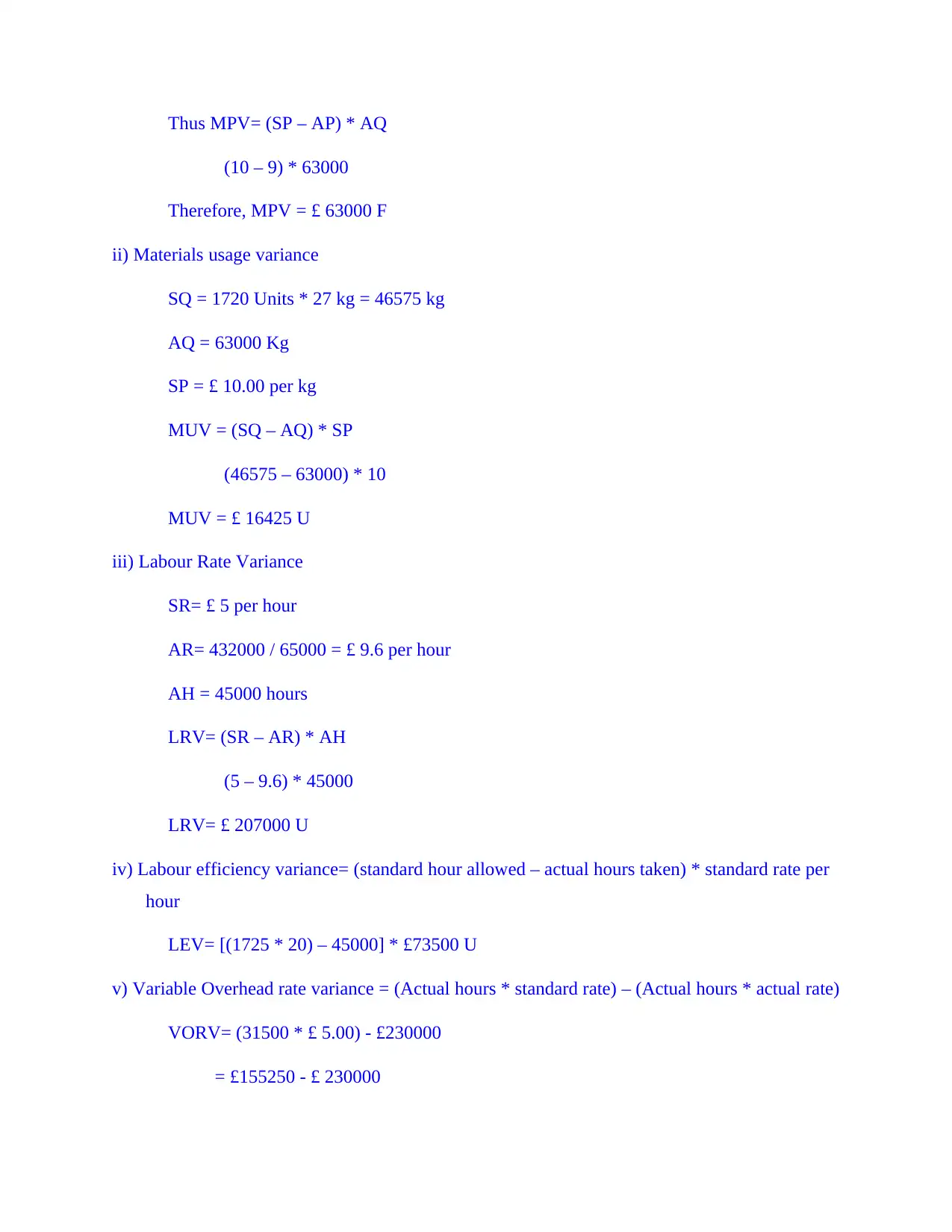
Thus MPV= (SP – AP) * AQ
(10 – 9) * 63000
Therefore, MPV = £ 63000 F
ii) Materials usage variance
SQ = 1720 Units * 27 kg = 46575 kg
AQ = 63000 Kg
SP = £ 10.00 per kg
MUV = (SQ – AQ) * SP
(46575 – 63000) * 10
MUV = £ 16425 U
iii) Labour Rate Variance
SR= £ 5 per hour
AR= 432000 / 65000 = £ 9.6 per hour
AH = 45000 hours
LRV= (SR – AR) * AH
(5 – 9.6) * 45000
LRV= £ 207000 U
iv) Labour efficiency variance= (standard hour allowed – actual hours taken) * standard rate per
hour
LEV= [(1725 * 20) – 45000] * £73500 U
v) Variable Overhead rate variance = (Actual hours * standard rate) – (Actual hours * actual rate)
VORV= (31500 * £ 5.00) - £230000
= £155250 - £ 230000
(10 – 9) * 63000
Therefore, MPV = £ 63000 F
ii) Materials usage variance
SQ = 1720 Units * 27 kg = 46575 kg
AQ = 63000 Kg
SP = £ 10.00 per kg
MUV = (SQ – AQ) * SP
(46575 – 63000) * 10
MUV = £ 16425 U
iii) Labour Rate Variance
SR= £ 5 per hour
AR= 432000 / 65000 = £ 9.6 per hour
AH = 45000 hours
LRV= (SR – AR) * AH
(5 – 9.6) * 45000
LRV= £ 207000 U
iv) Labour efficiency variance= (standard hour allowed – actual hours taken) * standard rate per
hour
LEV= [(1725 * 20) – 45000] * £73500 U
v) Variable Overhead rate variance = (Actual hours * standard rate) – (Actual hours * actual rate)
VORV= (31500 * £ 5.00) - £230000
= £155250 - £ 230000
Paraphrase This Document
Need a fresh take? Get an instant paraphrase of this document with our AI Paraphraser
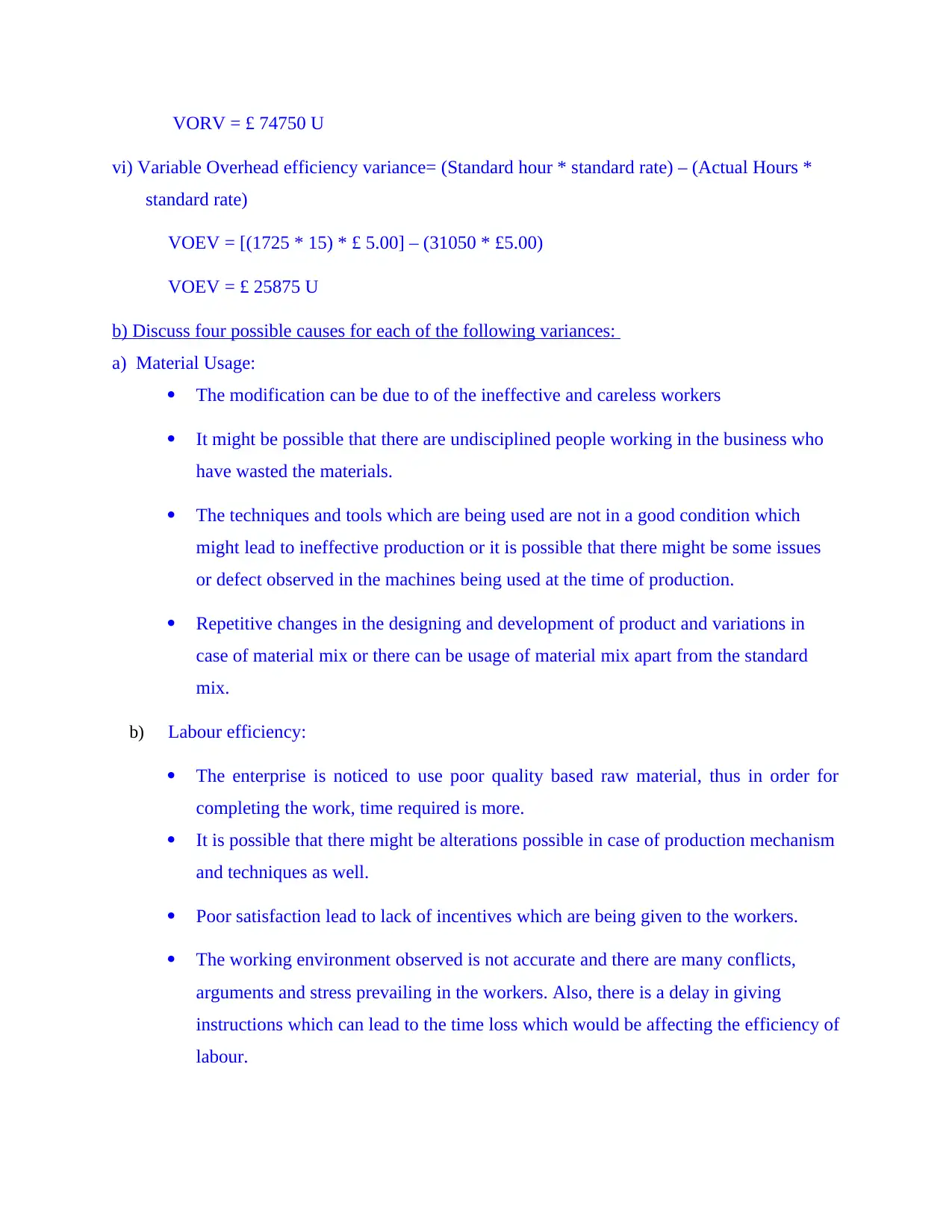
VORV = £ 74750 U
vi) Variable Overhead efficiency variance= (Standard hour * standard rate) – (Actual Hours *
standard rate)
VOEV = [(1725 * 15) * £ 5.00] – (31050 * £5.00)
VOEV = £ 25875 U
b) Discuss four possible causes for each of the following variances:
a) Material Usage:
The modification can be due to of the ineffective and careless workers
It might be possible that there are undisciplined people working in the business who
have wasted the materials.
The techniques and tools which are being used are not in a good condition which
might lead to ineffective production or it is possible that there might be some issues
or defect observed in the machines being used at the time of production.
Repetitive changes in the designing and development of product and variations in
case of material mix or there can be usage of material mix apart from the standard
mix.
b) Labour efficiency:
The enterprise is noticed to use poor quality based raw material, thus in order for
completing the work, time required is more.
It is possible that there might be alterations possible in case of production mechanism
and techniques as well.
Poor satisfaction lead to lack of incentives which are being given to the workers.
The working environment observed is not accurate and there are many conflicts,
arguments and stress prevailing in the workers. Also, there is a delay in giving
instructions which can lead to the time loss which would be affecting the efficiency of
labour.
vi) Variable Overhead efficiency variance= (Standard hour * standard rate) – (Actual Hours *
standard rate)
VOEV = [(1725 * 15) * £ 5.00] – (31050 * £5.00)
VOEV = £ 25875 U
b) Discuss four possible causes for each of the following variances:
a) Material Usage:
The modification can be due to of the ineffective and careless workers
It might be possible that there are undisciplined people working in the business who
have wasted the materials.
The techniques and tools which are being used are not in a good condition which
might lead to ineffective production or it is possible that there might be some issues
or defect observed in the machines being used at the time of production.
Repetitive changes in the designing and development of product and variations in
case of material mix or there can be usage of material mix apart from the standard
mix.
b) Labour efficiency:
The enterprise is noticed to use poor quality based raw material, thus in order for
completing the work, time required is more.
It is possible that there might be alterations possible in case of production mechanism
and techniques as well.
Poor satisfaction lead to lack of incentives which are being given to the workers.
The working environment observed is not accurate and there are many conflicts,
arguments and stress prevailing in the workers. Also, there is a delay in giving
instructions which can lead to the time loss which would be affecting the efficiency of
labour.
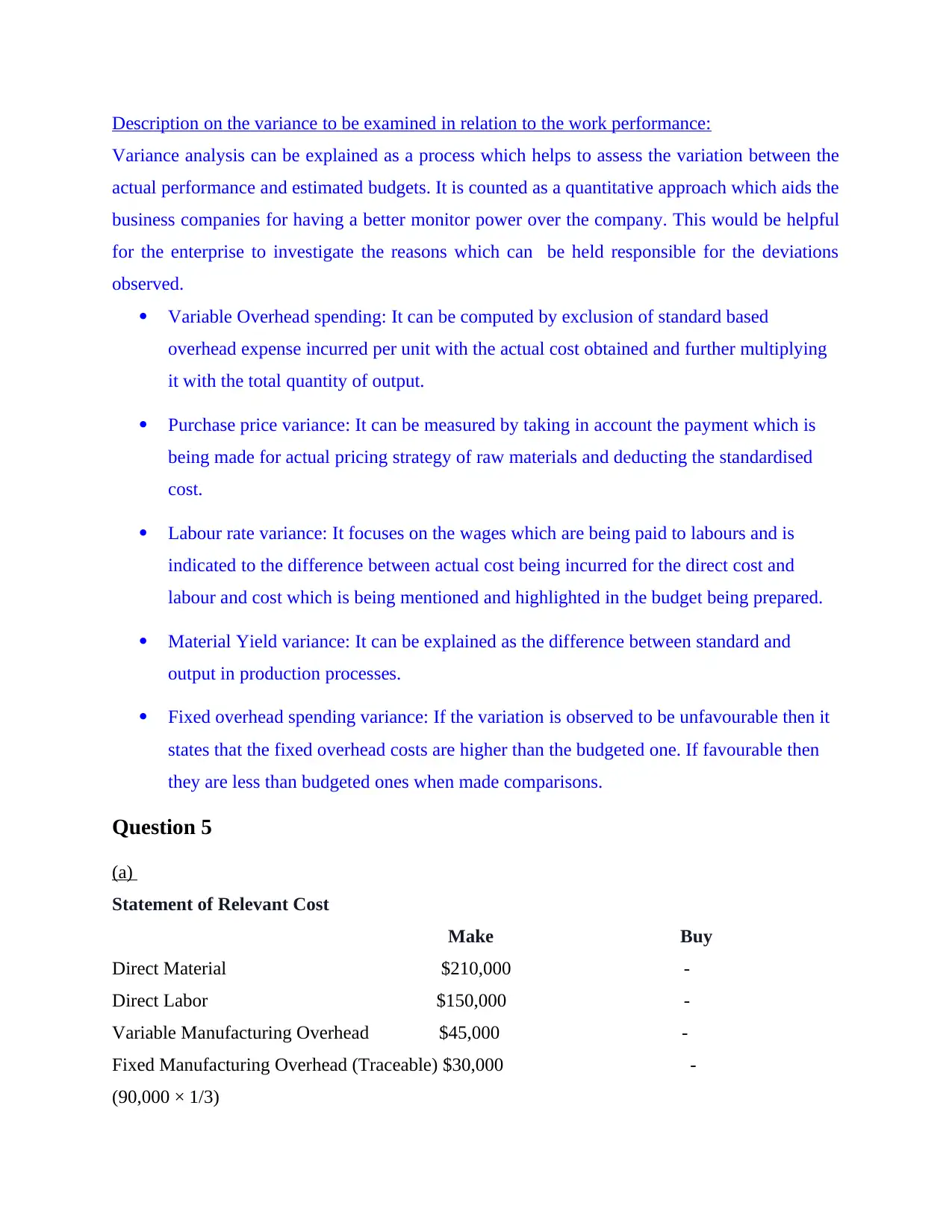
Description on the variance to be examined in relation to the work performance:
Variance analysis can be explained as a process which helps to assess the variation between the
actual performance and estimated budgets. It is counted as a quantitative approach which aids the
business companies for having a better monitor power over the company. This would be helpful
for the enterprise to investigate the reasons which can be held responsible for the deviations
observed.
Variable Overhead spending: It can be computed by exclusion of standard based
overhead expense incurred per unit with the actual cost obtained and further multiplying
it with the total quantity of output.
Purchase price variance: It can be measured by taking in account the payment which is
being made for actual pricing strategy of raw materials and deducting the standardised
cost.
Labour rate variance: It focuses on the wages which are being paid to labours and is
indicated to the difference between actual cost being incurred for the direct cost and
labour and cost which is being mentioned and highlighted in the budget being prepared.
Material Yield variance: It can be explained as the difference between standard and
output in production processes.
Fixed overhead spending variance: If the variation is observed to be unfavourable then it
states that the fixed overhead costs are higher than the budgeted one. If favourable then
they are less than budgeted ones when made comparisons.
Question 5
(a)
Statement of Relevant Cost
Make Buy
Direct Material $210,000 -
Direct Labor $150,000 -
Variable Manufacturing Overhead $45,000 -
Fixed Manufacturing Overhead (Traceable) $30,000 -
(90,000 × 1/3)
Variance analysis can be explained as a process which helps to assess the variation between the
actual performance and estimated budgets. It is counted as a quantitative approach which aids the
business companies for having a better monitor power over the company. This would be helpful
for the enterprise to investigate the reasons which can be held responsible for the deviations
observed.
Variable Overhead spending: It can be computed by exclusion of standard based
overhead expense incurred per unit with the actual cost obtained and further multiplying
it with the total quantity of output.
Purchase price variance: It can be measured by taking in account the payment which is
being made for actual pricing strategy of raw materials and deducting the standardised
cost.
Labour rate variance: It focuses on the wages which are being paid to labours and is
indicated to the difference between actual cost being incurred for the direct cost and
labour and cost which is being mentioned and highlighted in the budget being prepared.
Material Yield variance: It can be explained as the difference between standard and
output in production processes.
Fixed overhead spending variance: If the variation is observed to be unfavourable then it
states that the fixed overhead costs are higher than the budgeted one. If favourable then
they are less than budgeted ones when made comparisons.
Question 5
(a)
Statement of Relevant Cost
Make Buy
Direct Material $210,000 -
Direct Labor $150,000 -
Variable Manufacturing Overhead $45,000 -
Fixed Manufacturing Overhead (Traceable) $30,000 -
(90,000 × 1/3)
⊘ This is a preview!⊘
Do you want full access?
Subscribe today to unlock all pages.

Trusted by 1+ million students worldwide
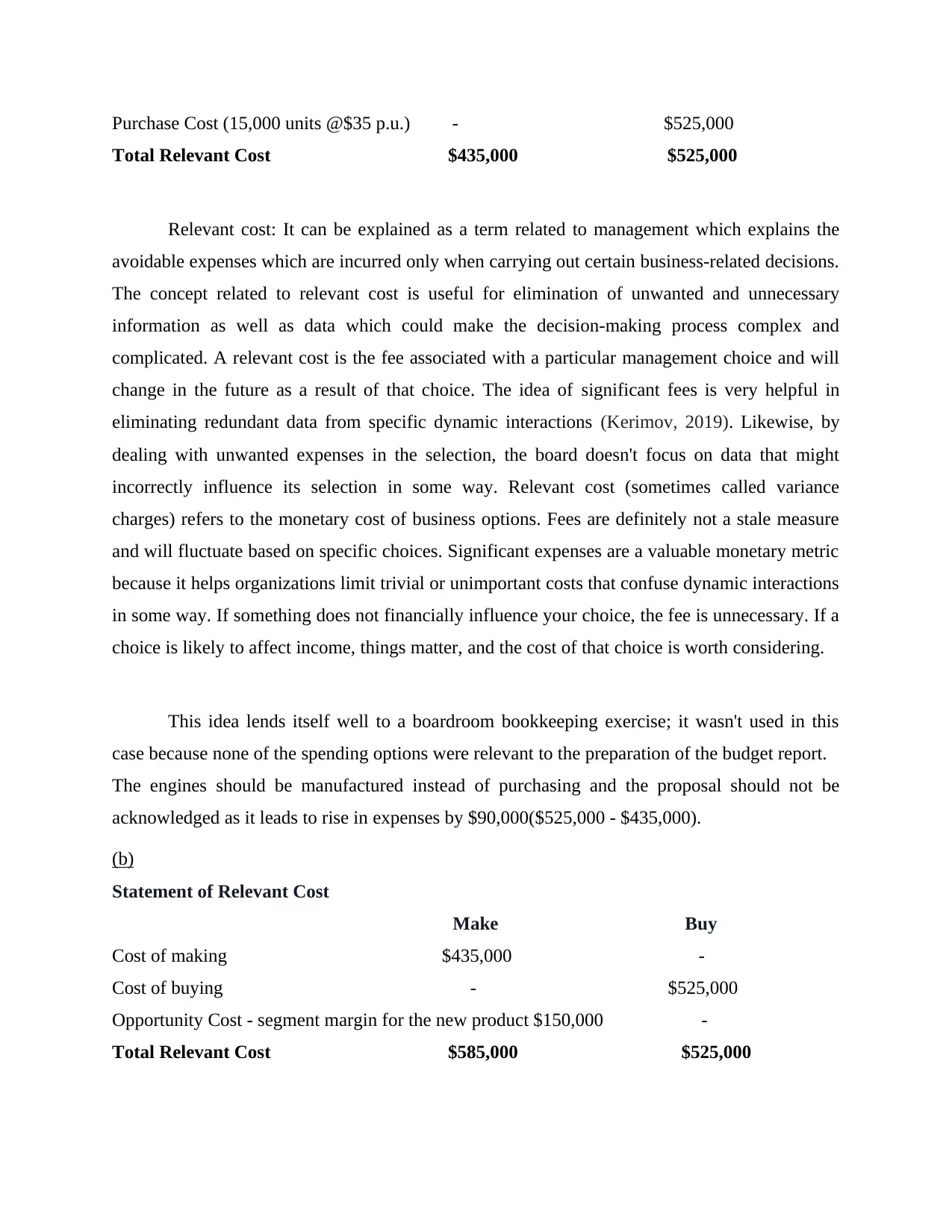
Purchase Cost (15,000 units @$35 p.u.) - $525,000
Total Relevant Cost $435,000 $525,000
Relevant cost: It can be explained as a term related to management which explains the
avoidable expenses which are incurred only when carrying out certain business-related decisions.
The concept related to relevant cost is useful for elimination of unwanted and unnecessary
information as well as data which could make the decision-making process complex and
complicated. A relevant cost is the fee associated with a particular management choice and will
change in the future as a result of that choice. The idea of significant fees is very helpful in
eliminating redundant data from specific dynamic interactions (Kerimov, 2019). Likewise, by
dealing with unwanted expenses in the selection, the board doesn't focus on data that might
incorrectly influence its selection in some way. Relevant cost (sometimes called variance
charges) refers to the monetary cost of business options. Fees are definitely not a stale measure
and will fluctuate based on specific choices. Significant expenses are a valuable monetary metric
because it helps organizations limit trivial or unimportant costs that confuse dynamic interactions
in some way. If something does not financially influence your choice, the fee is unnecessary. If a
choice is likely to affect income, things matter, and the cost of that choice is worth considering.
This idea lends itself well to a boardroom bookkeeping exercise; it wasn't used in this
case because none of the spending options were relevant to the preparation of the budget report.
The engines should be manufactured instead of purchasing and the proposal should not be
acknowledged as it leads to rise in expenses by $90,000($525,000 - $435,000).
(b)
Statement of Relevant Cost
Make Buy
Cost of making $435,000 -
Cost of buying - $525,000
Opportunity Cost - segment margin for the new product $150,000 -
Total Relevant Cost $585,000 $525,000
Total Relevant Cost $435,000 $525,000
Relevant cost: It can be explained as a term related to management which explains the
avoidable expenses which are incurred only when carrying out certain business-related decisions.
The concept related to relevant cost is useful for elimination of unwanted and unnecessary
information as well as data which could make the decision-making process complex and
complicated. A relevant cost is the fee associated with a particular management choice and will
change in the future as a result of that choice. The idea of significant fees is very helpful in
eliminating redundant data from specific dynamic interactions (Kerimov, 2019). Likewise, by
dealing with unwanted expenses in the selection, the board doesn't focus on data that might
incorrectly influence its selection in some way. Relevant cost (sometimes called variance
charges) refers to the monetary cost of business options. Fees are definitely not a stale measure
and will fluctuate based on specific choices. Significant expenses are a valuable monetary metric
because it helps organizations limit trivial or unimportant costs that confuse dynamic interactions
in some way. If something does not financially influence your choice, the fee is unnecessary. If a
choice is likely to affect income, things matter, and the cost of that choice is worth considering.
This idea lends itself well to a boardroom bookkeeping exercise; it wasn't used in this
case because none of the spending options were relevant to the preparation of the budget report.
The engines should be manufactured instead of purchasing and the proposal should not be
acknowledged as it leads to rise in expenses by $90,000($525,000 - $435,000).
(b)
Statement of Relevant Cost
Make Buy
Cost of making $435,000 -
Cost of buying - $525,000
Opportunity Cost - segment margin for the new product $150,000 -
Total Relevant Cost $585,000 $525,000
Paraphrase This Document
Need a fresh take? Get an instant paraphrase of this document with our AI Paraphraser
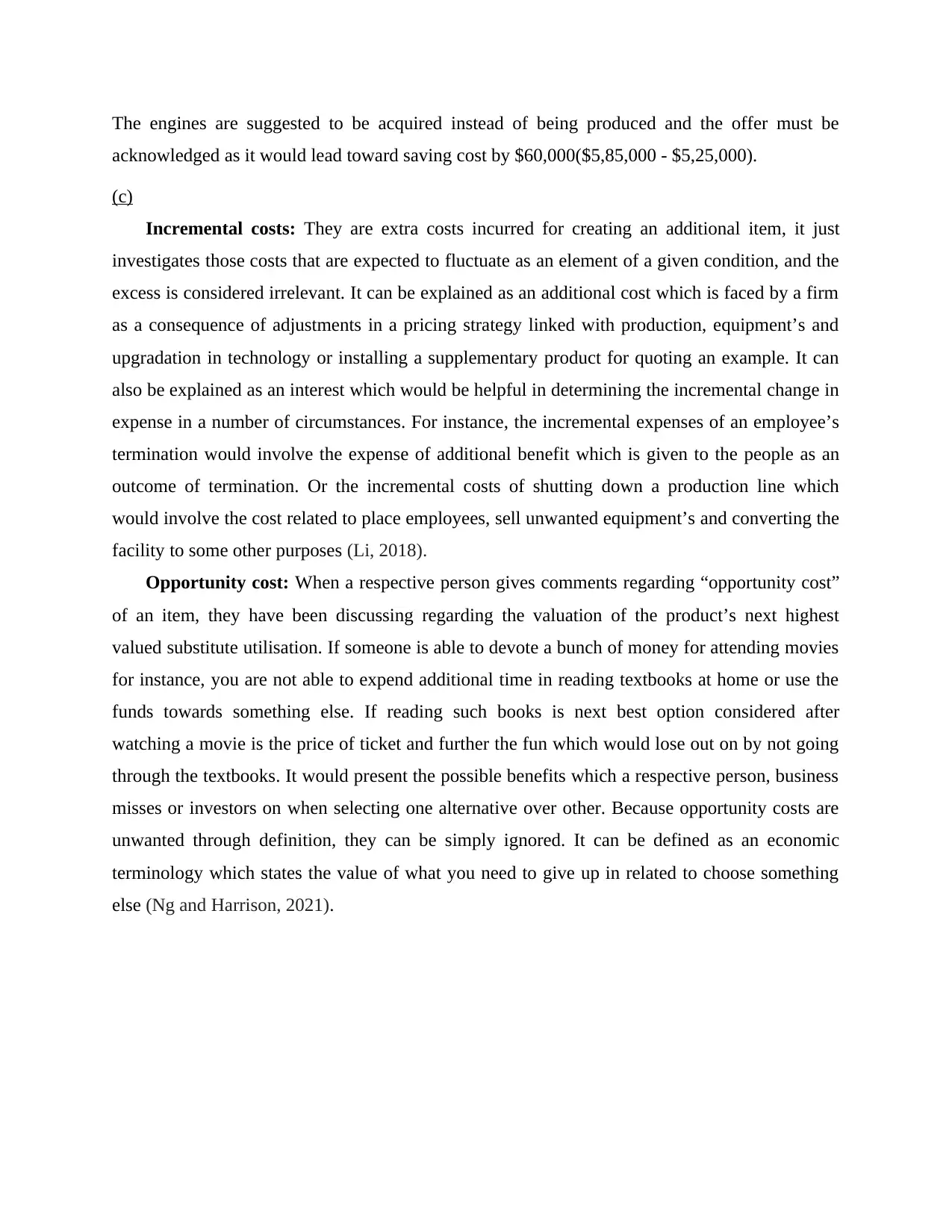
The engines are suggested to be acquired instead of being produced and the offer must be
acknowledged as it would lead toward saving cost by $60,000($5,85,000 - $5,25,000).
(c)
Incremental costs: They are extra costs incurred for creating an additional item, it just
investigates those costs that are expected to fluctuate as an element of a given condition, and the
excess is considered irrelevant. It can be explained as an additional cost which is faced by a firm
as a consequence of adjustments in a pricing strategy linked with production, equipment’s and
upgradation in technology or installing a supplementary product for quoting an example. It can
also be explained as an interest which would be helpful in determining the incremental change in
expense in a number of circumstances. For instance, the incremental expenses of an employee’s
termination would involve the expense of additional benefit which is given to the people as an
outcome of termination. Or the incremental costs of shutting down a production line which
would involve the cost related to place employees, sell unwanted equipment’s and converting the
facility to some other purposes (Li, 2018).
Opportunity cost: When a respective person gives comments regarding “opportunity cost”
of an item, they have been discussing regarding the valuation of the product’s next highest
valued substitute utilisation. If someone is able to devote a bunch of money for attending movies
for instance, you are not able to expend additional time in reading textbooks at home or use the
funds towards something else. If reading such books is next best option considered after
watching a movie is the price of ticket and further the fun which would lose out on by not going
through the textbooks. It would present the possible benefits which a respective person, business
misses or investors on when selecting one alternative over other. Because opportunity costs are
unwanted through definition, they can be simply ignored. It can be defined as an economic
terminology which states the value of what you need to give up in related to choose something
else (Ng and Harrison, 2021).
acknowledged as it would lead toward saving cost by $60,000($5,85,000 - $5,25,000).
(c)
Incremental costs: They are extra costs incurred for creating an additional item, it just
investigates those costs that are expected to fluctuate as an element of a given condition, and the
excess is considered irrelevant. It can be explained as an additional cost which is faced by a firm
as a consequence of adjustments in a pricing strategy linked with production, equipment’s and
upgradation in technology or installing a supplementary product for quoting an example. It can
also be explained as an interest which would be helpful in determining the incremental change in
expense in a number of circumstances. For instance, the incremental expenses of an employee’s
termination would involve the expense of additional benefit which is given to the people as an
outcome of termination. Or the incremental costs of shutting down a production line which
would involve the cost related to place employees, sell unwanted equipment’s and converting the
facility to some other purposes (Li, 2018).
Opportunity cost: When a respective person gives comments regarding “opportunity cost”
of an item, they have been discussing regarding the valuation of the product’s next highest
valued substitute utilisation. If someone is able to devote a bunch of money for attending movies
for instance, you are not able to expend additional time in reading textbooks at home or use the
funds towards something else. If reading such books is next best option considered after
watching a movie is the price of ticket and further the fun which would lose out on by not going
through the textbooks. It would present the possible benefits which a respective person, business
misses or investors on when selecting one alternative over other. Because opportunity costs are
unwanted through definition, they can be simply ignored. It can be defined as an economic
terminology which states the value of what you need to give up in related to choose something
else (Ng and Harrison, 2021).
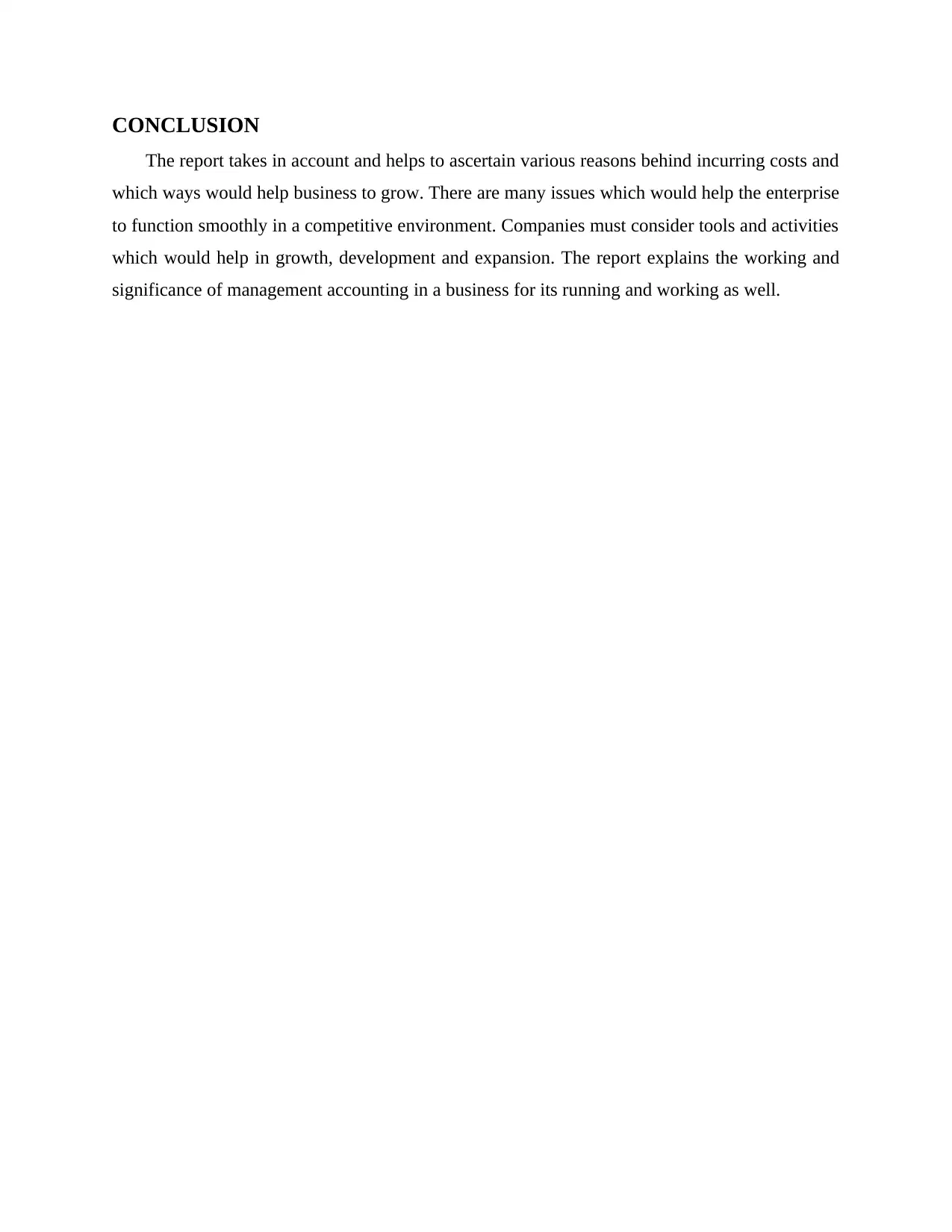
CONCLUSION
The report takes in account and helps to ascertain various reasons behind incurring costs and
which ways would help business to grow. There are many issues which would help the enterprise
to function smoothly in a competitive environment. Companies must consider tools and activities
which would help in growth, development and expansion. The report explains the working and
significance of management accounting in a business for its running and working as well.
The report takes in account and helps to ascertain various reasons behind incurring costs and
which ways would help business to grow. There are many issues which would help the enterprise
to function smoothly in a competitive environment. Companies must consider tools and activities
which would help in growth, development and expansion. The report explains the working and
significance of management accounting in a business for its running and working as well.
⊘ This is a preview!⊘
Do you want full access?
Subscribe today to unlock all pages.

Trusted by 1+ million students worldwide
1 out of 13
Related Documents
Your All-in-One AI-Powered Toolkit for Academic Success.
+13062052269
info@desklib.com
Available 24*7 on WhatsApp / Email
![[object Object]](/_next/static/media/star-bottom.7253800d.svg)
Unlock your academic potential
Copyright © 2020–2025 A2Z Services. All Rights Reserved. Developed and managed by ZUCOL.




